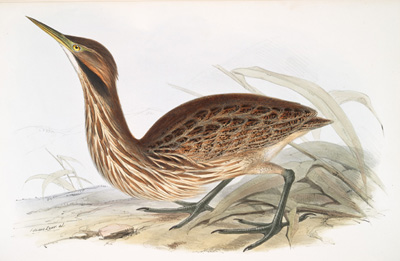

• Intro / Home
• Historical Neighbors
• Street and Backyard
Neighbors
• Park and Green Places
Neighbors
• Shore and Wetlands
Neighbors
• Salt and Freshwater
Neighbors
• Tiny Neighbors
• Unwelcome Neighbors
• Occasional and
Unexpected Neighbors
•
Wildlife Sighting Log
• Resources
• Hours and Tours
• Press Release
• NYPL HOME
| Shore and Wetlands Neighbors | |
 |
||
|
|
John Gould (1804–1881) wrote and published 14 large-format multivolume zoologies, most of them devoted to birds, illustrated with 2,999 lithographs by five leading animal artists of the period. Although Edward Lear (1812–1888) is known generally for his nonsense verse, he is considered among the finest of bird painters. In addition to his own 1830–32 study of the parrot family, his art enriched three of Gould’s ornithologies. Although Botaurus lentiginosus is an American bird (described accurately in the text, although the picture caption is incorrect), Gould was not wrong in including it in Birds of Europe: individuals have been seen in Great Britain. A large (up to 34 inches tall), solitary member of the heron family, the Bittern sports cryptic plumage that camouflages it in marshland reeds and grasses, where it feeds on various small creatures including fish, amphibians, and insects. Check out the sighting log to record your interaction with some of the native New York City wildlife, such as the American Bittern, featured in Urban Neighbors. You may also browse the sighting log by animal, borough, park or natural area, and/or habitat to view a sighting you have submitted or to read others’ observations. |